|
|
|
|
|
|
|
|
|
|
|
|
|
|
|
|
|
|
|

|
Current Exhibitions Future Exhibitions Back to Exhibitions Exhibition Checklist  Untitled (Horses with Female Form), detail, n.d. Acrylic on wood panel, 9 x 31.75 in. Collection of Joanna Ross, Oakwood, Ohio 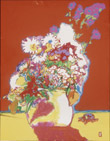 Flowers and Vase, 2004. Acrylic on canvas, 20 x 30 in. Flowers and Vase, 2004. Acrylic on canvas, 20 x 30 in.
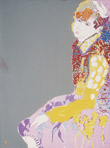 Student Posing, 2002. Acrylic on canvas, 16 x 30 in.
Student Posing, 2002. Acrylic on canvas, 16 x 30 in.
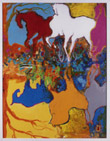 Meditations, 2002. Acrylic on canvas, 27.5 x 21.5 in. Collection of Joanna Ross, Oakwood, Ohio
Meditations, 2002. Acrylic on canvas, 27.5 x 21.5 in. Collection of Joanna Ross, Oakwood, Ohio
 Untitled (Five Horses I), n.d. Acrylic on canvas, 16 x 20 in.
Untitled (Five Horses I), n.d. Acrylic on canvas, 16 x 20 in.
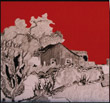 Old Farmhouse, 2004. Graphite/charcoal on paper, 12 x 12 in.
Old Farmhouse, 2004. Graphite/charcoal on paper, 12 x 12 in.
|
John Warden MacKenzie: The Artist as Messenger August 12–September 12, 2004 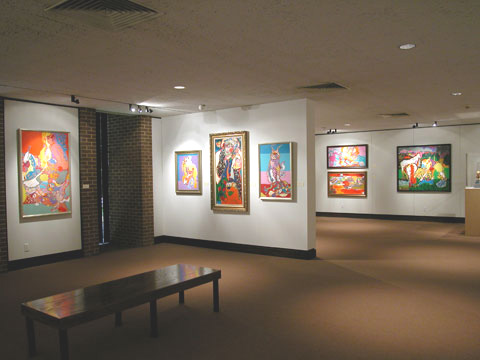
John Warden MacKenzie begins his paintings by directly sketching onto canvas with pencil. He allows his hand to move freely as his imagination unfolds. Sometimes, these initial pencil drawings are still visible beneath the paint he later applies. This pentimento is instructional in that it gives clues as to how an idea develops. In other pieces, such as Fisher (2004) and Old Farmhouse (2004), the drawing itself is the central element with paint and color framing out the scene. Among MacKenzie's favorite motifs are the horse and buffalo, which appear in numerous compositions. According to the artist, the horse is the most graceful form after the human figure, and he points to the use of the animal in artwork throughout the centuries. The buffalo is a portrayal of an actual animal that the artist encountered while in an arroyo in the desert near his home outside El Paso. That day, an old buffalo cow came very near to MacKenzie, and he was able to take several photographs upon which his drawings and paintings are based. A wild buffalo is rare in that part of the country, and the experience has influenced the artist's work for several years since. Flowers are another frequent motif because, according to the artist, "they are wonderful things." For MacKenzie, roses have a particularly deep meaning, as they have been used symbolically in poetry and art. The artist speaks of one painting in which Christ's blood turns into roses. MacKenzie's "signature," incorporating the image of a raven, holds special meaning. The artist based his symbol on an actual raven that he observed isolated in a cage at the Alamogordo Zoo in New Mexico. According to the explanatory signage on the bird's cage, the zookeepers isolated it because the other birds were attacking it. MacKenzie identified with the raven because, as a child he, too, felt isolated, withdrawn and extremely shy.MacKenzie lists Albert Pinkham Ryder (1847-1917), Winslow Homer (1836-1910), Eugène Delacroix (1798-1863), Gustav Klimt (1862-1918), and Alphonse Mucha (1860-1939) as having heavily influenced his own artistic development and personal philosophy. It is easy to see elements of Mucha's sinewy, stylized compositions and Klimt's frontal compositions with his figures of haunting beauty woven into this artist's works. MacKenzie admires the simple dedication to "art over social position" that Ryder and Homer espoused, and he points to Delacroix's use of imagination and bright colors as an important means of artistic expression and individuality. MacKenzie's art is accessible first because of its colorful presence. A viewer encountering MacKenzie's work may initially be unaware that a painting, which appears at first glance to depict a scene of innocent beauty, may, in fact, illustrate more brutal and powerful elements in nature. This can be seen in works such as Bobcat with Kill (2002), Buffalo Stampede (2003) and Wolves Attacking Horse (2004). In paintings that include human figures, the subjects seem to melt into the overall composition, and faces emerge as central focal points, anchoring the compositions and creating a brooding, thoughtful or dreamy atmosphere. Especially powerful are Student Posing (2002), Mother and Daughter (2003), Dreams of Centaurs (2004) and The Voyager (2004). John Warden MacKenzie was born in Albany, California, in 1942, to an Australian mother and a father whose family was from New Zealand. The family moved to Saudi Arabia in 1949 when MacKenzie's father went to work for the Arabian-American Oil Company. Young MacKenzie, then seven years old, began his artistic education in Dhahran, Saudi Arabia. In 1955 he continued his studies in Dhahran under the instruction of Benjamin Martinez. The following year, MacKenzie, by then 14 years old, was studying drawing and painting with Jon Anderson in Rastanura, Saudi Arabia. When it came time for MacKenzie to enter high school, his parents sent him to Rome, Italy, where for three years he took art classes at the Roman Forum, the American Academy of Art and the Vatican Museum in Vatican City (Rome), Italy. Following high school he attended the University of New Mexico in Albuquerque, graduating with a bachelor of arts degree in English literature with a minor in archeology. His hope to major in art was discouraged by his father. With his newly minted college degree, MacKenzie became a United States Customs Agent. Several years prior to retiring, MacKenzie went back to school to study watercolor and drawing at the University of Texas at El Paso (1975). In 1998, he apprenticed with Texas artist William Arthur Herring. MacKenzie's greatest recognition in recent years has come for his paintings of children in and around his home in Fort Hancock, Texas. In 1998, the City of El Paso and the Lincoln Cultural Arts Center in El Paso hired MacKenzie through a federally funded program to teach art in a variety of schools and recreation centers. During this period, which the artist has described as a virtual training ground, he learned how to draw fast ("children move about a lot") and to work with confidence in front of people. He has subsequently created murals at Myrtle Cooper and Vista del Sol Elementary Schools in El Paso (1998), and he has produced portraits of children at Providence Memorial Hospital (El Paso, 2002) and at the Denver Museum of Art (2001). MacKenzie's works have been exhibited in several one-man and group shows in El Paso and are also included in numerous private collections in California, Colorado, Florida, Georgia, New Mexico, Oregon and Texas, as well as in Mexico. Other works may be found in the permanent collections of the Museum of Durat Malik Abdul Azia Jidda (Saudi Arabia), the Lincoln Cultural Arts Center (El Paso), El Paso International Museum and the Centennial Museum of the University of Texas at El Paso. Currently, the artist lives and works outside of El Paso in Fort Hancock, Texas, with his wife Mayela. We would like to thank Joanna Ross, the artist's daughter, for her generosity and assistance in making this exhibition possible and for her loans to this exhibition, and especially the artist for sharing his art with our visitors. |